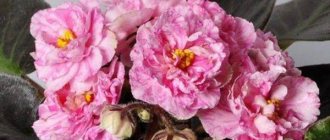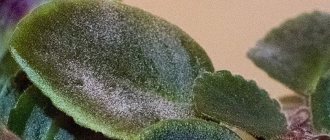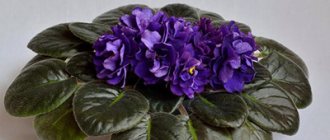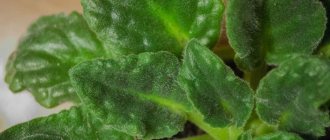The flower collections of many gardeners always include violets . And how can you not love these beautiful flowers? With a wide variety of varieties, everyone can choose a plant to their liking and taste. The names and lovers of only Saintpaulia are well known:
- They have separate places, shelves and stands . And greenhouses;
- grow and propagate violets ;
- Wide field of activity. There is plenty to pay attention to and choose the varieties you like : Terry;
- Ampelous;
- Variegated;
- Chimeras;
- Miniatures;
- Trailers.
For many peoples of the world, violets are symbols of spring, joy and tenderness :
- The Japanese believe that violet is the soul of spring;
- The Italians are even more specific. A man who has never given a bouquet of violets has never loved;
- This is also about Saintpaulias.
They began to gain popularity with the flower exhibition in Ghent in 1893 :
- Presented on it for the first time by the German botanist Hermann Wendland;
- Called Saintpaulia (Sauntpolia ionanta). Saintpaulia violetflower or Saintpaulia violetflower.
- Grown from the seeds of flowers presented by the Barons of Saint-Paul;
- They grow naturally mainly in the Uzambara Mountains of East Africa. Flower growers also call them African violets. Or Uzambara violet ;
- The variability of Saintpaulias (in the color and shape of flowers and leaves) allowed breeders to produce amazing flowers;
- And to the 20 species in nature, thousands of hybrids .
Attention! It’s difficult to count them now. Flower growers say there are more than 30 thousand of them.
Violet Kentucky Baby Bells
Excellent violet Kentucky Baby Bells.
The author of the variety is D. Rollins. Above is a photo of a Kentucky Baby Bells violet. The description of the variety states that these are white bells with a delicate pink eye and imprints. Foliage:
- Saturated;
- Green;
- With white variegation.
The variety is classified as miniature .
The miniature variety is easy to grow.
Saintpaulia is not the most difficult to grow , but it reacts very clearly to temperature changes. According to the description, the flowers should be white with pink prints. But in extreme heat they turn almost pink.
If there is a need to grow a violet for an exhibition, then the outlet is placed in a room with a constantly running air conditioner . The bell should remain half open.
Saintpaulia needs moist indoor air.
It reproduces well and can be easily grown from leaf cuttings . The variety takes root well and produces several children. The rosette is formed smoothly and does not create any special problems. Sometimes there are specimens with particularly pronounced variegation; such plants are of particular value.
The rosette of this variety is very miniature and even.
Varietal characteristics are transferred well, but it can give sports . They appear as a lack of variegation, pink bells or semi-double flowers.
Attention! Sometimes there is pink variegation on the leaves. This indicates that the rosette will produce dark pink flowers instead of white ones.
This variety has a sport.
Features of flowering, growth and reproduction
The rosette is very beautiful , even if there are no flowers on it. There are a lot of white areas on the leaves.
In order to grow a full-fledged plant from a cutting, it will take at least 12 months . The Kentucky Baby Bells violet, like all varieties with pronounced variegation, develops very slowly.
Saintpaulia grows and develops very slowly.
In order to grow this plant, it is worth taking cuttings with a lot of green color. It is also very important to wait until the babies turn green before separating them from the mother leaf. If the baby's leaves are completely white and have no greenery, then photosynthesis processes will become impossible. Kids like this:
- They die;
- Or they develop very slowly.
Saintpaulia Kentucky Baby Bells is most often propagated from leaf cuttings. Varietal characteristics are conveyed well. The mutation most often appears as semi-doubleness or darkening.
Violet can also be propagated by lateral stepsons . But before separating the sprout from the stem, you should wait for green areas to appear on the leaf blades. The more there are, the faster the young rosette will develop.
The variety reproduces well by leaf.
The variety is sensitive to heat. At high temperatures, the flowers change from white with pink markings to completely pink. Pink color may also appear on the leaves. Peduncles:
- Tall;
- Sturdy;
- They hold flowers well in weight.
Each of them can have up to seven buds. It blooms long and profusely, constantly producing new flower stalks. Cap flowering is not difficult to achieve.
Reviews about violet
Alexandra, Moscow: “You cannot expect that the first flowering will be perfect. If the buds were planted in the heat, then the pink color is guaranteed. Before throwing away or donating a rosette, you should wait for the second flowering.”
Svetlana, Cherepovets: “I bought a baby of this variety. Develops slowly. Pink areas appeared on the leaves. I can’t tell if it’s a sport or if she’s lacking nutrients. I’ll wait for the flowering.”
Violet Buckeye Blushing
Author of the variety
The magnificent violet "Buckeye Blushing" represents the development of American breeder Pat Hancock from Middletown, Ohio.
The master works only with Saintpaulias, which are characterized by the variegated color of the leaf rosette, and its trademark is certainly the aligned contour of the bush.
The variety has been appearing at exhibitions since 2003.
Taxonomy
According to the taxonomic classification, Violet Buckeye Blushing represents the genus Saintpaulia from the Gesnerieceae family.
The diameter of the leaf rosette of considerable size allows us to classify the variety as a large standard ; based on the fullness of the corolla, the variety is defined as a terry variety , and based on the color of the leaf blades, it is a variegated group .
Description of appearance
Saintpaulia independently forms a leaf rosette of considerable size , the size of which gives the right to consider the violet as a large standard type.
The bushes in any collection have aligned outlines and a beautiful distribution of leaves into tiers based on the mosaic principle . Thanks to the decorative qualities of the rosette, the violet always looks excellent, even without flowers.
Saintpaulia leaf blades are distinguished by a quilted surface structure, finely notched serrations and a dark green color with a thin frame of beige streaks and spots with pinkish reflections.
IMPORTANT! Leaf petioles in rare cases have an elongated structure.
Photo of Buckeye Blushing violet.
Flowering occurs in a bouquet type with the formation of large buds that open with corollas of double or semi-double fullness.
The petals of each flower have a slightly wavy edge, which gives the corolla additional volume.
The flowers are painted in transitions of lavender shades with an increase in color intensity to a violet tone in fancy specks and the edges of the petals.
ATTENTION! A characteristic feature of the variety is clear triangular-shaped prints on the tips of the petals.
Sports
Saintpaulia can not very often form sports , characterized by increased corrugation of the contours of the inner petals with a yellowish-lemon color.
Features of flowering, growth and reproduction
All life processes follow the classical pattern of development and growth of variegated Saintpaulias, with sometimes minor nuances occurring.
Plant development indoors
Violet is a variety with an unpretentious character - it does not impose excessive standards on maintenance methods, which is not entirely typical for variegated varieties.
The independent formation of a rosette ends with the development of a well-groomed bush with a straightened contour. The leaves are distributed evenly, do not stick up and do not fall down.
Flowering lasts almost without a break for rest , each phase stretches for a period of one to three months . Buds are formed in large numbers.
Features of the development include:
- the plant’s fear of sudden changes in temperature;
- negative reaction to overflow when watering;
- negative attitude towards artificial light - with such lighting the flowerpot begins to hug.
Time of formation of an adult plant
If a new violet is planned to be obtained from a leaf cutting, then the first flowering, and therefore the complete maturation of the specimen, will occur 8–10 months after rooting.
When you obtain an adult bush by rooting a baby from the mother plant, this process will speed up a little.
Reproduction methods and features
To obtain new specimens of Saintpaulia, flower growers use two methods:
- rooting of stepsons formed on the mother plant;
- obtaining children from leaf cuttings and then rooting them.
Children on a violet cutting.
ATTENTION! It is not recommended to propagate violets by seed, since almost all of them belong to hybrid forms, and in hybrids, varietal characteristics are not transmitted through sexual reproduction.
To preserve the characteristics of the variety, the rejuvenation method is suitable.
Flowering in hot and cool conditions
The flowering of variegated varieties of violets with fancy patterns on the corollas occurs better and brighter at cool temperatures.
A lower temperature in the room also helps to increase the duration of preservation of the corollas in a decorative state, that is, it extends their flowering period.
Elevated temperatures at the time of bud formation and flower blooming are fraught with changes in flowering time or complete refusal of it.
Corollas that bloom in the heat will have an unpresentable appearance and will wither much faster.
Appearance of peduncles
Saintpaulia develops not very long, branched and strong peduncles that easily hold heavy buds in an upright position. Planting persistent peduncles guarantees the decorative flowering of the specimen.
Flowering type
Varietal violet blooms in a bouquet type - the blossoming corollas form well-groomed bouquets on erect peduncles in the center of the leaf rosette. The double structure of the flowers and the wavy edges of the petals add decorative value to the bouquets.
Bud lifespan
Saintpaulia blooms for a period of one to three months , maintaining its decorative effect throughout this period. A single corolla can live for one to one and a half months. Cool content can increase this time.
Reviews
Olga Mikhailovna. “I have been growing Saintpaulia “Buckeye Blushing” for a very long time. I like the variety for its even rosette and long flowering. But I want to warn novice flower growers: never put this violet on a rack - it will start hugging the flowerpot. Its place is on the windowsill.”
Kirill Stepanovich. “I don’t know how to classify my Buckeye Blushing violet.” According to one description, it should have clear triangles on the edge of the petals, in another – delicate fantasy prints. My violet has triangles that seem to be fantasy, but too bright. So I’m guessing, but I really like the plant.”
Violet Kentucky Baby Sister
Delicate violet Kentucky Baby Sister.
Authorship belongs to D. Rollins . The flowers are white stars, with a slightly wavy green edge and a darkened pink-fuchsia eye. The foliage is dark green with bright white variegation.
The Kentucky Baby Sister violet is considered a miniature, but it is more likely to be classified as a semi miniature . Socket:
- Neat;
- Easy to form.
Variegation is more pronounced in cool conditions . In hot weather, the leaves become greener.
Saintpaulia often produces uneven flowers.
Very often the variety does not produce the most even and beautiful colors. We can say that instead of stars we get krakozyabrs, especially during the first flowering . To be sure of the exact absence of varietal characteristics, it is worth waiting for the second flowering.
Sports varieties appear as an irregular flower shape , lack of white tint on the petals.
Features of growth, flowering and reproduction
The variety feels great at home. Not capricious , grows and develops well.
This variety is very easy to care for.
An adult plant can be grown in 10-12 months . Can be grown both from cuttings and from lateral sprouts. Varietal characteristics are transmitted well, but do not always appear during the first flowering. Most often, deviations appear in the shape of a flower.
The varietal characteristic is a slightly wavy edge. But it often happens that the petals:
- Twisted;
- They don't straighten out;
- They wither and dry up in a semi-dissolved state.
In such cases, it is worth following the fertilizer application schedule , or waiting for re-blooming. For the rosette to show itself in all its glory, you should give it time. This is an individual feature of the variety.
Saintpaulia flower stalks tend to droop from the weight of the flowers.
Peduncles are tall but thin. They often end up on the socket, which ends up looking like a trailer.
In the heat, the pink-fuchsia eye often becomes larger in size , and the violet swims. There are many flower stalks, the rosette produces them constantly. It often blooms with a lush head of flowers.
Attention! The flowering period is long, new buds appear constantly.
Reviews about violet
Elena, St. Petersburg: “My violet has already given its first bloom. The flowers opened well, unlike other greenfinches. But the socket is a little larger than I expected. It can be classified more as a semi-mini than a miniature. But perhaps my pot is just too big and should be replanted.”
Kristina, Moscow: “My violet gave some untidy flowers - at first they stand, and then they begin to fall on the rosette. The shape of the flowers is not the most neat and even. I'm not very happy with this. Although the peephole inside the bud looks very nice. Perhaps, indeed, you should heed the advice and wait until it matures.”
Violet Buckley's Spoon (Buckley)
Author of the variety
The original Saintpaulia Buckley's Spoon was introduced to the global violet growing community by breeder HW Buckley.
Taxonomy
According to the taxonomic classification, the Usambara violet Buckley's Spoon is classified as a member of the genus Saintpaulia, which is part of the Gesneriaceae family.
Based on the size of the leaf rosette, the variety can be considered a type of semi-miniature , based on the fullness of the corolla, it is a simple violet , and based on the color of the petals, the plant belongs to the monochromatic varieties.
Description of appearance
Saintpaulia Buckley's Spoon, forming a small leaf rosette, belongs to the type of semi-miniatures.
The main value of this Saintpaulia lies in its unusually interesting leaf blades . They are located on very long petioles, turning in different directions and breaking symmetry. But violet flower growers forgive this behavior of leaves for the originality of the leaf shape.
Each leaf bends its side edges like a spoon , inside which, like a saucer, there is a convex-concave venation pattern with a deepened central vein of a salad tone.
The upper side of the leaves has a shiny, quilted surface structure and is painted in a dark shade of marsh color.
The lower one is distinguished by a light, whitish tonality, which creates a feeling of sharp contrast at the place where the leaf plate turns.
FOR YOUR INFORMATION! Violet leaves can be called a smaller copy of the leaves of the Victoria Regia water lily.
Photo of Buckley's Spoon violet.
Violets bloom with the simplest corollas of blue or lilac colors , reminiscent of the first varieties of Saintpaulia that appeared. Peduncles are formed throughout the rosette, forming not a cap type, but a corolla.
The flowers themselves fade quickly enough , but they can also fall off just like that.
No sports were observed in the variety.
Features of flowering, growth and reproduction
All phases of life activity in violets correspond to the usual growth pattern of varietal Saintpaulias with minor deviations and nuances.
Plant development indoors
The variety is unique in the structure of its leaf blades , but can cause gardeners many problems when forming a rosette. This is an extremely harmful variety of violet.
The ideally curved edges of the leaves, guaranteed by the varietal description, may not be obtained by curling in different directions . The leaf may not form a spoon shape at all, remaining completely flat, and sometimes spontaneously breaks or cracks, then overgrown with ugly scars.
Due to the leaf petioles being too long, the variety’s rosette does not have an even and dense configuration. The leaves develop in different directions, with large empty spaces formed between them. The decorative quality of violets suffers from this.
The untidiness of the violet is given by its maintenance on wick watering , from which the petioles of the leaves are stretched even more.
The characteristics of the variety include:
- violet’s love for long-lasting natural light;
- negative reaction to the wick method of watering;
- heat intolerance - leaves turn in the other direction at high temperatures, a decrease in temperature returns to the shape of a spoon.
Time of formation of an adult plant
Obtaining a young violet capable of forming buds depends on the method of its propagation:
- When rooted by leaf cuttings, the plant needs time to produce children and for their formation. This process may take up to 10 months;
- if the shoots formed on the violet itself take root, the time before flowering is somewhat reduced, since the baby is already ready.
Reproduction methods and features
The variety can propagate exclusively by vegetative methods:
- or leaf cuttings;
- or by stepsons separated from the maternal specimen.
Stepchildren of violets.
Both methods are completely easy to use and accessible to all gardeners. The main thing is to be careful when working with delicate children.
A feature of the propagation of violets is the impossibility of transmitting varietal characteristics during sexual reproduction , since almost all varieties of Saintpaulia today are hybrids. In this case, you can use the rejuvenation method, in which the characteristics of the variety remain unchanged.
Flowering in hot and cool conditions
The coincidence of the violet flowering period with hot weather can slow down the formation of buds in order to transfer this phase to a more suitable time. If the buds still open at elevated temperatures, then the flowers do not have a decorative gloss.
Saintpaulia prefers to bloom in cool microclimates , which usually occurs in early spring or during autumn weather.
Flowering type
Due to the elongated peduncles and their formation throughout the entire volume of the leaf rosette, violets never bloom in a cap type.
Its flowering is characterized by small corollas or single flowers , which are almost always present on Saintpaulia in most cases.
However, this does not spoil the overall impression of the violet, since it is usually valued due to the unusual shape of the leaves.
Appearance of peduncles
Saintpaulia is distinguished by elongated, insufficiently strong peduncles, which leads to the formation of a corolla during flowering instead of a cap or bouquet.
Flowers can sometimes fall onto the leaves of the rosette.
Bud lifespan
The variety is a representative of a small group of violets that have a relatively short period of preserving the decorative appearance of their blossoming corollas.
Individual buds dry out extremely quickly or simply fall off while in bloom.
Reviews
Trofim Petrovich. “Colleagues gave me Saintpaulia Buckley's Spoon, hinting at the uniqueness of the variety. I tried to form a rosette in every possible way, but I ended up with a completely unkempt, branching violet. Having given up trying, I left the plant alone, after which I accidentally discovered what was unique about it. My pest pleased me with smooth and round leaves-plates. It looks like a tropical Victoria water lily has grown on the window.”
Eleanor. “I really love the non-standard manifestations of violets: original corollas, strange colors, unusual bud shapes. For this reason, I have a Buckley's Spoon violet. For its leaves, I agree to endure the whims and harmful nature of the plant.”
Caring for a plant at home
Miniature violets require the same conditions as regular ones :
- No temperature changes;
- Scattered light;
- Proper watering.
Watering should be done with settled water at room temperature. Wick watering is allowed, but it is best to water from above.
To avoid overwatering, you can fill almost half the pot with sphagnum moss .
Fertilizers are added to water for irrigation . They should not be given more than once or twice a month. Otherwise, the miniatures grow greatly, and the beautiful flowers are lost against the background of the foliage. Overfeeding with nitrogen manifests itself in the form of a thick and fleshy middle of the leaf blade. If there is too much phosphorus, the leaves begin to turn yellow. If the plant lacks nutrients, the veins begin to turn pale.
During the flowering period, you should increase :
- Degree of illumination;
- And the length of daylight hours artificially.
Also during this period, phosphorus fertilizers begin to be applied .
Violets do not tolerate heat well. This is manifested in the fact that the dark eye, which is located in the center of the flower, begins to creep towards the edge of the petals and the violet floats. This phenomenon occurs even if the rosette formed flower stalks in the heat and blooms in the cool.
Air humidity should be at 55%.
For growing miniature Saintpaulias, standard mixtures are suitable, without excessive amounts of fertilizers and nutrients. It is best to use a lump of sphagnum as drainage for miniatures . This greatly simplifies the process of replanting the plant. It is also very convenient to root in sphagnum:
- Leaf cuttings;
- Or side stepsons.
In miniatures, leaf yellowing is very rarely observed . Such Saintpaulias, provided they are well cared for, can be replanted every few years. They can produce lush flowering even at a very mature age without regular rejuvenation.
Attention! After transplanting into a fresh substrate, the violet can bloom in two months.
Sometimes young rosettes produce lateral stepsons . This is not a consequence of poor care. This phenomenon is a feature of almost all miniature varieties. In this case, it is worth monitoring the formation of lateral growth points and removing them in time.
The lateral stepson can be additionally rooted and a new plant can be obtained. Saintpaulias can also be propagated using leaf cuttings.











